Pengfei Guo
Text-Driven Tumor Synthesis
Dec 24, 2024



Abstract:Tumor synthesis can generate examples that AI often misses or over-detects, improving AI performance by training on these challenging cases. However, existing synthesis methods, which are typically unconditional -- generating images from random variables -- or conditioned only by tumor shapes, lack controllability over specific tumor characteristics such as texture, heterogeneity, boundaries, and pathology type. As a result, the generated tumors may be overly similar or duplicates of existing training data, failing to effectively address AI's weaknesses. We propose a new text-driven tumor synthesis approach, termed TextoMorph, that provides textual control over tumor characteristics. This is particularly beneficial for examples that confuse the AI the most, such as early tumor detection (increasing Sensitivity by +8.5%), tumor segmentation for precise radiotherapy (increasing DSC by +6.3%), and classification between benign and malignant tumors (improving Sensitivity by +8.2%). By incorporating text mined from radiology reports into the synthesis process, we increase the variability and controllability of the synthetic tumors to target AI's failure cases more precisely. Moreover, TextoMorph uses contrastive learning across different texts and CT scans, significantly reducing dependence on scarce image-report pairs (only 141 pairs used in this study) by leveraging a large corpus of 34,035 radiology reports. Finally, we have developed rigorous tests to evaluate synthetic tumors, including Text-Driven Visual Turing Test and Radiomics Pattern Analysis, showing that our synthetic tumors is realistic and diverse in texture, heterogeneity, boundaries, and pathology.
VILA-M3: Enhancing Vision-Language Models with Medical Expert Knowledge
Nov 19, 2024



Abstract:Generalist vision language models (VLMs) have made significant strides in computer vision, but they fall short in specialized fields like healthcare, where expert knowledge is essential. In traditional computer vision tasks, creative or approximate answers may be acceptable, but in healthcare, precision is paramount.Current large multimodal models like Gemini and GPT-4o are insufficient for medical tasks due to their reliance on memorized internet knowledge rather than the nuanced expertise required in healthcare. VLMs are usually trained in three stages: vision pre-training, vision-language pre-training, and instruction fine-tuning (IFT). IFT has been typically applied using a mixture of generic and healthcare data. In contrast, we propose that for medical VLMs, a fourth stage of specialized IFT is necessary, which focuses on medical data and includes information from domain expert models. Domain expert models developed for medical use are crucial because they are specifically trained for certain clinical tasks, e.g. to detect tumors and classify abnormalities through segmentation and classification, which learn fine-grained features of medical data$-$features that are often too intricate for a VLM to capture effectively especially in radiology. This paper introduces a new framework, VILA-M3, for medical VLMs that utilizes domain knowledge via expert models. Through our experiments, we show an improved state-of-the-art (SOTA) performance with an average improvement of ~9% over the prior SOTA model Med-Gemini and ~6% over models trained on the specific tasks. Our approach emphasizes the importance of domain expertise in creating precise, reliable VLMs for medical applications.
MAISI: Medical AI for Synthetic Imaging
Sep 13, 2024Abstract:Medical imaging analysis faces challenges such as data scarcity, high annotation costs, and privacy concerns. This paper introduces the Medical AI for Synthetic Imaging (MAISI), an innovative approach using the diffusion model to generate synthetic 3D computed tomography (CT) images to address those challenges. MAISI leverages the foundation volume compression network and the latent diffusion model to produce high-resolution CT images (up to a landmark volume dimension of 512 x 512 x 768 ) with flexible volume dimensions and voxel spacing. By incorporating ControlNet, MAISI can process organ segmentation, including 127 anatomical structures, as additional conditions and enables the generation of accurately annotated synthetic images that can be used for various downstream tasks. Our experiment results show that MAISI's capabilities in generating realistic, anatomically accurate images for diverse regions and conditions reveal its promising potential to mitigate challenges using synthetic data.
A Short Review and Evaluation of SAM2's Performance in 3D CT Image Segmentation
Aug 20, 2024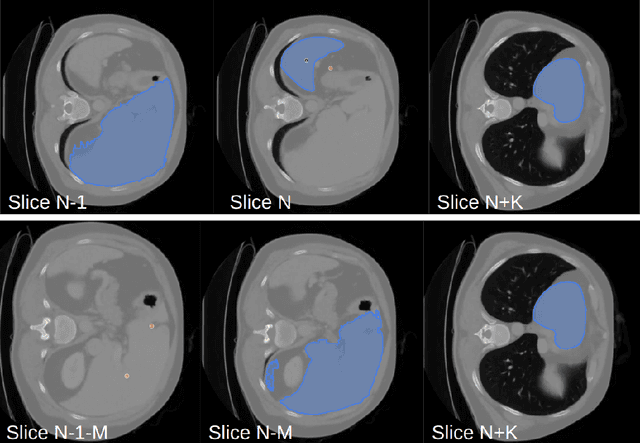
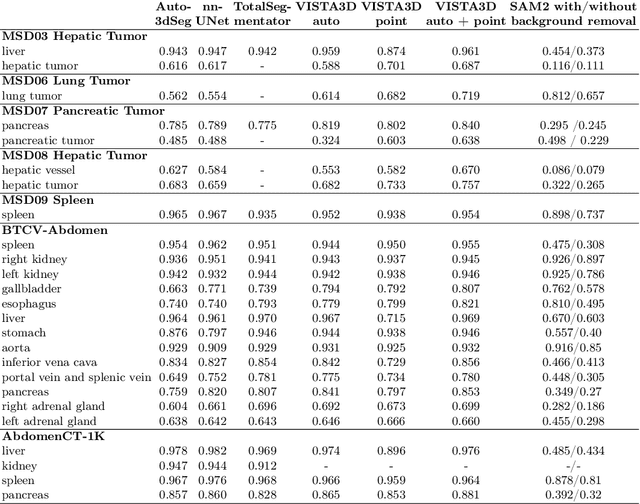
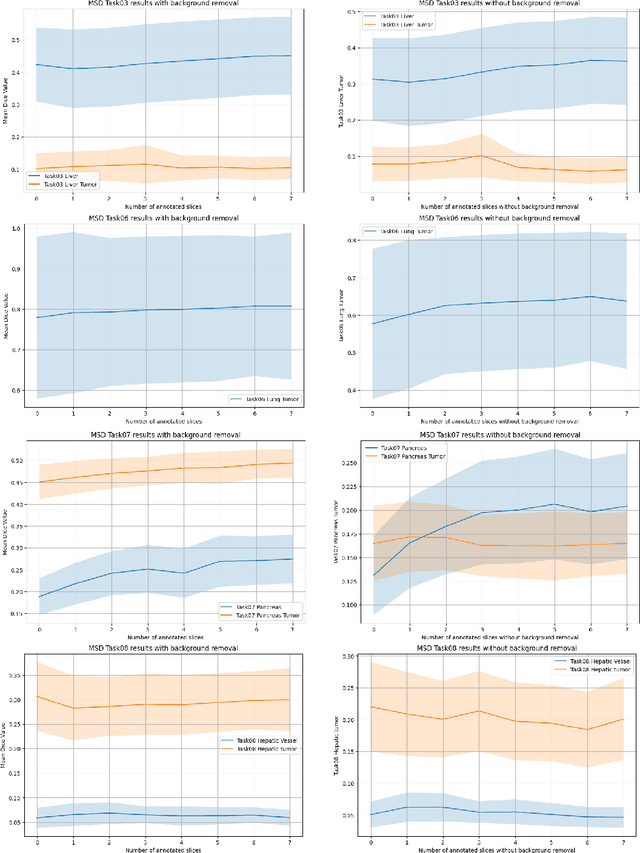
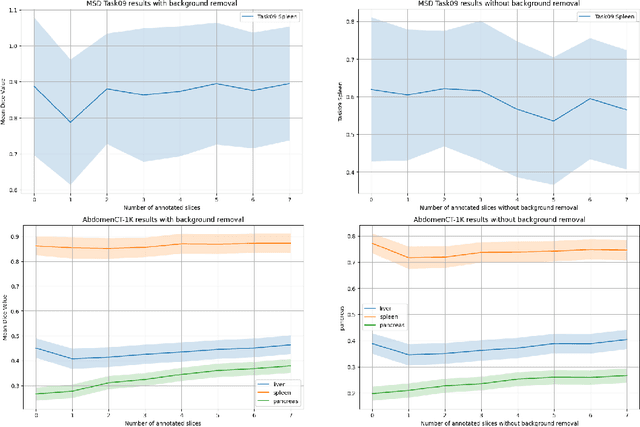
Abstract:Since the release of Segment Anything 2 (SAM2), the medical imaging community has been actively evaluating its performance for 3D medical image segmentation. However, different studies have employed varying evaluation pipelines, resulting in conflicting outcomes that obscure a clear understanding of SAM2's capabilities and potential applications. We shortly review existing benchmarks and point out that the SAM2 paper clearly outlines a zero-shot evaluation pipeline, which simulates user clicks iteratively for up to eight iterations. We reproduced this interactive annotation simulation on 3D CT datasets and provided the results and code~\url{https://github.com/Project-MONAI/VISTA}. Our findings reveal that directly applying SAM2 on 3D medical imaging in a zero-shot manner is far from satisfactory. It is prone to generating false positives when foreground objects disappear, and annotating more slices cannot fully offset this tendency. For smaller single-connected objects like kidney and aorta, SAM2 performs reasonably well but for most organs it is still far behind state-of-the-art 3D annotation methods. More research and innovation are needed for 3D medical imaging community to use SAM2 correctly.
VISTA3D: Versatile Imaging SegmenTation and Annotation model for 3D Computed Tomography
Jun 07, 2024Abstract:Segmentation foundation models have attracted great interest, however, none of them are adequate enough for the use cases in 3D computed tomography scans (CT) images. Existing works finetune on medical images with 2D foundation models trained on natural images, but interactive segmentation, especially in 2D, is too time-consuming for 3D scans and less useful for large cohort analysis. Models that can perform out-of-the-box automatic segmentation are more desirable. However, the model trained in this way lacks the ability to perform segmentation on unseen objects like novel tumors. Thus for 3D medical image analysis, an ideal segmentation solution might expect two features: accurate out-of-the-box performance covering major organ classes, and effective adaptation or zero-shot ability to novel structures. In this paper, we discuss what features a 3D CT segmentation foundation model should have, and introduce VISTA3D, Versatile Imaging SegmenTation and Annotation model. The model is trained systematically on 11454 volumes encompassing 127 types of human anatomical structures and various lesions and provides accurate out-of-the-box segmentation. The model's design also achieves state-of-the-art zero-shot interactive segmentation in 3D. The novel model design and training recipe represent a promising step toward developing a versatile medical image foundation model. Code and model weights will be released shortly. The early version of online demo can be tried on https://build.nvidia.com/nvidia/vista-3d.
Towards Federated Learning Under Resource Constraints via Layer-wise Training and Depth Dropout
Sep 11, 2023Abstract:Large machine learning models trained on diverse data have recently seen unprecedented success. Federated learning enables training on private data that may otherwise be inaccessible, such as domain-specific datasets decentralized across many clients. However, federated learning can be difficult to scale to large models when clients have limited resources. This challenge often results in a trade-off between model size and access to diverse data. To mitigate this issue and facilitate training of large models on edge devices, we introduce a simple yet effective strategy, Federated Layer-wise Learning, to simultaneously reduce per-client memory, computation, and communication costs. Clients train just a single layer each round, reducing resource costs considerably with minimal performance degradation. We also introduce Federated Depth Dropout, a complementary technique that randomly drops frozen layers during training, to further reduce resource usage. Coupling these two techniques enables us to effectively train significantly larger models on edge devices. Specifically, we reduce training memory usage by 5x or more in federated self-supervised representation learning and demonstrate that performance in downstream tasks is comparable to conventional federated self-supervised learning.
MoViT: Memorizing Vision Transformers for Medical Image Analysis
Apr 04, 2023Abstract:The synergy of long-range dependencies from transformers and local representations of image content from convolutional neural networks (CNNs) has led to advanced architectures and increased performance for various medical image analysis tasks due to their complementary benefits. However, compared with CNNs, transformers require considerably more training data, due to a larger number of parameters and an absence of inductive bias. The need for increasingly large datasets continues to be problematic, particularly in the context of medical imaging, where both annotation efforts and data protection result in limited data availability. In this work, inspired by the human decision-making process of correlating new ``evidence'' with previously memorized ``experience'', we propose a Memorizing Vision Transformer (MoViT) to alleviate the need for large-scale datasets to successfully train and deploy transformer-based architectures. MoViT leverages an external memory structure to cache history attention snapshots during the training stage. To prevent overfitting, we incorporate an innovative memory update scheme, attention temporal moving average, to update the stored external memories with the historical moving average. For inference speedup, we design a prototypical attention learning method to distill the external memory into smaller representative subsets. We evaluate our method on a public histology image dataset and an in-house MRI dataset, demonstrating that MoViT applied to varied medical image analysis tasks, can outperform vanilla transformer models across varied data regimes, especially in cases where only a small amount of annotated data is available. More importantly, MoViT can reach a competitive performance of ViT with only 3.0% of the training data.
Deep-learning-enabled Brain Hemodynamic Mapping Using Resting-state fMRI
Apr 25, 2022



Abstract:Cerebrovascular disease is a leading cause of death globally. Prevention and early intervention are known to be the most effective forms of its management. Non-invasive imaging methods hold great promises for early stratification, but at present lack the sensitivity for personalized prognosis. Resting-state functional magnetic resonance imaging (rs-fMRI), a powerful tool previously used for mapping neural activity, is available in most hospitals. Here we show that rs-fMRI can be used to map cerebral hemodynamic function and delineate impairment. By exploiting time variations in breathing pattern during rs-fMRI, deep learning enables reproducible mapping of cerebrovascular reactivity (CVR) and bolus arrive time (BAT) of the human brain using resting-state CO2 fluctuations as a natural 'contrast media'. The deep-learning network was trained with CVR and BAT maps obtained with a reference method of CO2-inhalation MRI, which included data from young and older healthy subjects and patients with Moyamoya disease and brain tumors. We demonstrate the performance of deep-learning cerebrovascular mapping in the detection of vascular abnormalities, evaluation of revascularization effects, and vascular alterations in normal aging. In addition, cerebrovascular maps obtained with the proposed method exhibited excellent reproducibility in both healthy volunteers and stroke patients. Deep-learning resting-state vascular imaging has the potential to become a useful tool in clinical cerebrovascular imaging.
Escaping Data Scarcity for High-Resolution Heterogeneous Face Hallucination
Mar 30, 2022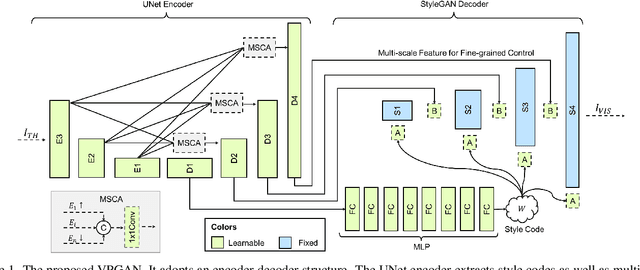
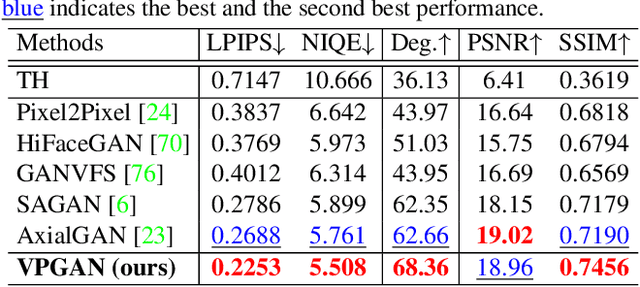
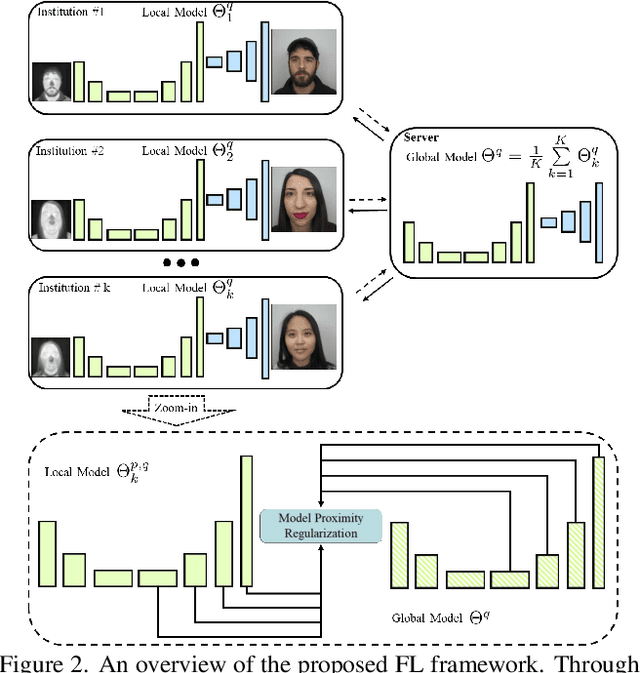
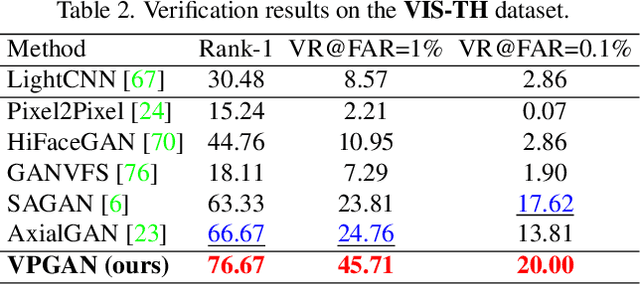
Abstract:In Heterogeneous Face Recognition (HFR), the objective is to match faces across two different domains such as visible and thermal. Large domain discrepancy makes HFR a difficult problem. Recent methods attempting to fill the gap via synthesis have achieved promising results, but their performance is still limited by the scarcity of paired training data. In practice, large-scale heterogeneous face data are often inaccessible due to the high cost of acquisition and annotation process as well as privacy regulations. In this paper, we propose a new face hallucination paradigm for HFR, which not only enables data-efficient synthesis but also allows to scale up model training without breaking any privacy policy. Unlike existing methods that learn face synthesis entirely from scratch, our approach is particularly designed to take advantage of rich and diverse facial priors from visible domain for more faithful hallucination. On the other hand, large-scale training is enabled by introducing a new federated learning scheme to allow institution-wise collaborations while avoiding explicit data sharing. Extensive experiments demonstrate the advantages of our approach in tackling HFR under current data limitations. In a unified framework, our method yields the state-of-the-art hallucination results on multiple HFR datasets.
Closing the Generalization Gap of Cross-silo Federated Medical Image Segmentation
Mar 18, 2022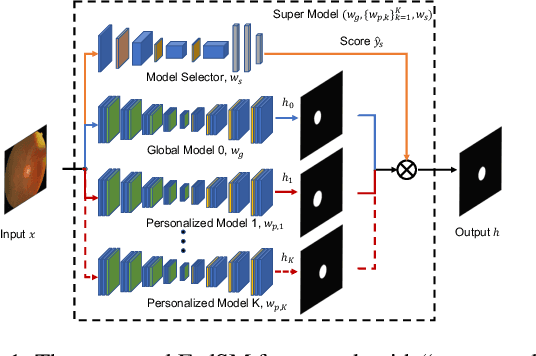



Abstract:Cross-silo federated learning (FL) has attracted much attention in medical imaging analysis with deep learning in recent years as it can resolve the critical issues of insufficient data, data privacy, and training efficiency. However, there can be a generalization gap between the model trained from FL and the one from centralized training. This important issue comes from the non-iid data distribution of the local data in the participating clients and is well-known as client drift. In this work, we propose a novel training framework FedSM to avoid the client drift issue and successfully close the generalization gap compared with the centralized training for medical image segmentation tasks for the first time. We also propose a novel personalized FL objective formulation and a new method SoftPull to solve it in our proposed framework FedSM. We conduct rigorous theoretical analysis to guarantee its convergence for optimizing the non-convex smooth objective function. Real-world medical image segmentation experiments using deep FL validate the motivations and effectiveness of our proposed method.
 Add to Chrome
Add to Chrome Add to Firefox
Add to Firefox Add to Edge
Add to Edge